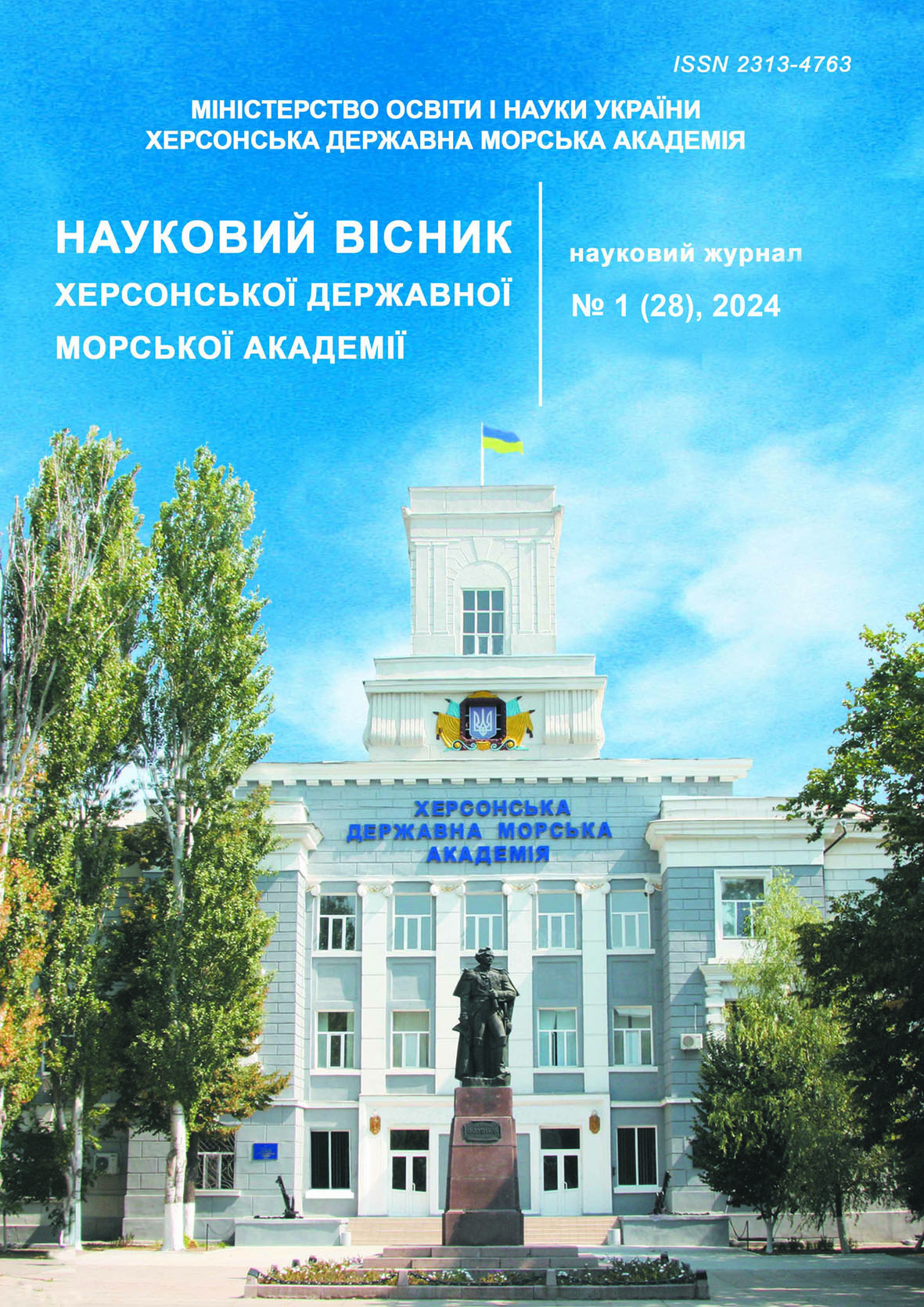USING REDUNDANT CONTROL TO MINIMIZE ENERGY CONSUMPTION
https://doi.org/10.33815/2313-4763.2024.1.28.163-173
Abstract
Reducing energy consumption in maritime transport, as well as the associated emission reductions and environmental improvements, are particularly relevant. The ways of solving these issues are different, but most often structural solutions, hydrodynamic solutions, sails, or modern power plants are used. Reducing energy consumption can also be achieved due to proper route planning, psychological training of the crew, automation of traffic control processes. The article proposes a method to minimize energy consumption using redundant control. Redundant structures of actuating devices are widely used on modern ships, in particular, on ships with a dynamic positioning system. Traditional purpose of redundant structures is to increase the reliability of the actuating control system and increase the maneuverability of the vessel. The proposed method also uses redundant structures available on ships to minimize fuel consumption. The subject of research are models and methods of optimizing energy consumption, due to the use of redundant control. The aim of the study is to minimize energy consumption for operations. To solve the problem, a systematic approach, analysis and synthesis, imaginary experiment, methods of automatic control theory, numerical methods of conditional optimization, and mathematical modeling were used. The scientific novelty of the obtained results consists in the development of a method for determining optimal controls that minimize energy costs for performing operations by solving optimization problem with constraints in the on-board computer of the automatic or automated control system, unlike known solutions, it uses redundant controls for optimization and allows reducing energy costs by (35–50) %. At the same time, the additional load on the calculation cycle of the on-board computer does not exceed (25–50) ms, which is (2.5–5) % of the total load. The practical value of the obtained results consists in checking the workability and efficiency of the developed method by mathematical modeling and the possibility of its use in the on-board computer of the automated ship motion control system with redundant structures of actuating devices.
References
2. Kai, L., Yanyun, Y., Yunlong, W., Zhenwu, H. (2018). Research on structural optimization method of FRP fishing vessel based on artificial bee colony algorithm, Advances in Engineering Software, 250–261. doi: 10.1016/j.advengsoft.2018.03.011.
3. Feng, Y., Chen, Z., Dai, Yi, Wang, F., Cai, J., Shen, Z. (2018). Multidisciplinary optimization of an offshore aquaculture vessel hull form based on the support vector regression surrogate model, Ocean Engineering, 145–158. doi: 10.1016/j.oceaneng.2018.07.062.
4. Ma, Y., Bi, H., Hu, M., Zheng, Y., Gan, L. (2019). Hard sail optimization and energy efficiency enhancement for sail-assisted vessel, Ocean Engineering, 687–699. doi: 10.1016/j.oceaneng.2019.01.026.
5. Zinchenko, S., Tovstokoryi, O., Sapronov, O., Petrovskyi, A., Ivanov, A., Tymofeiev, K. (2022). Development of automatic control methods of vessel rotation around the pivot point without drift, Technology Audit and Production Reserves, 6(2(68), 16–21. https://doi.org/10.15587/2706-5448.2022.269364.
6. Zinchenko, S. M., Mamenko, P. P., Grosheva, O. O., Mateichuk, V. M. (2019). Automatic control of the vessel’s movement under external conditions, Naukovyi Visnyk KSMA, №2(21), s. 10–15. DOI: 10.33815/2313-4763.2019.2.21.010-015. http://journals.ksma.ks.ua/nvksma/ article/view/ 480/416.
7. Moiseenko, V. S., Zinchenko, S. M., Tovstokoryi, O. M. (2020). Automatic beam control of laser–optical position reference system, Materials of the II International Scientific and Practical Maritime Conference of the Department of Power Plants and TE of Odessa National Maritime University MPP & O-2020, April 2020, Odessa-Istambul-Odessa. https://drive. google.com/file/d/1HEX2RVuA1KV5JjMfQcqYZ1f4SCFMcy6a/view.
8. Zinchenko, S., Tovstokoryi, O. (2020). What is the pivot point and how to use it to control the vessel, Materials of the XII International Scientific and Practical Conference "Advanced Information and Innovative Technologies for Transport (MINTТ – 2020), May 27–29, 2020, Kherson
9. Luo, M., Shin, S. (2019). Half-century research developments in maritime accidents: Future directions, Accident Analysis & Prevention, 448–460. doi: 10.1016/j.aap.2016.04.010.
10. Jacobellis, G., Gandhi, F., Floros, M. (2019). Using Control Redundancy for Power and Vibration Reduction on a Coaxial Rotor Helicopter at High Speeds, Journal of the american helicopter society. doi: 10.4050/JAHS.64.032008.
11. Gao, W., Tang, Q., Yao, J., Yang, Y. (2020). Automatic motion planning for complex welding problems by considering angular redundancy, Robotics and Computer-Integrated Manufacturing, doi: 10.1016/j.rcim.2019.101862.
12. Pakaste, R., Laukia, K., Wilhelmson, M., Kuuskoski, J. (1999) Experience with Azipod®propulsion systems on board marine vessels, Marine Propulsion. https://library. e.abb.com/public/2314773146eb2d77c1256ec300341511/12-18%20ENG%209902.pdf.
13. IMCA Marine Division: Guidelines for the design and operation of dynamically positioned vessels. (2019). The International Marine Contractors Association. https://www.imca-int.com/product/guidelines-for-the-design-and-operation-of-dynamically-positioned-vessels/.
14. Cheng, X., Deng, S., Cheng, B., Meiqian, L., Zhou, R. (2020). Optimization of bias current coefficient in the fault-tolerance of active magnetic bearings based on the redundant structure parameters, Automatika, 602–613. doi: 10.1080/00051144.2020.1806012.
15. Santos, M. F., Santos Neto, A. F., Honorio, L., Silva, M. F., Mercorelli, P. (2023). Robust and Optimal Control Designed for Autonomous Surface Vessel Prototypes, IEEE Access, (99):1–1. doi: 10.1109/ACCESS.2023.3239591.
16. Rigatos, G. A. (2022). Nonlinear optimal control approach for underactuated offshore cranes, Ships and Offshore Structures. doi: 10.1080/17445302.2022.2150420.
17. Bao, X., Jiang, C. (2023). Time-Optimal Control Algorithm of Aircraft Maneuver, in book: Advances in Guidance, Navigation and Control, Proceedings of 2022 International Conference on Guidance, Navigation and Control. DOI: 10.1007/978-981-19-6613-2_454.
18. Bartels, S., Helling, S., Meurer, T. (2023). Inequality Constrained Optimal Control for Rope-Assisted ASV Docking Maneuvers, IFAC-PapersOnLine, pp. 44–49. doi: 10.1016/j.ifacol.2022.10.407.
19. Leparoux, C., Herisse, B., Jean, F. (2022). Structure of optimal control for planetary landing with control and state constraints, ESAIM Control Optimisation and Calculus of Variations. doi: 10.1051/cocv/2022065.
20. Huang, W., Xu, H., Wang, J., Miao, C., Ren, Y., Wang, L. (2020). Redundancy Management for Fault-tolerant Control System of an Unmanned Underwater Vehicle, 5th International Conference on Automation, Control and Robotics Engineering (CACRE): Proceedings, China, 19–20 Sept. 2020. doi: 10.1109/CACRE50138.2020.9230038.
21. Li, W., Shi, G. (2020). Redundancy management strategy for electro-hydraulic actuators based on intelligent algorithms, Advances in Mechanical Engineering. doi: 10.1177/ 1687814020930455.
22. Piloting Vessels Fitted with Azimuthing Control Devices (ACD’s). (2013). United Kingdom Maritime Pilot’s Association (UKMPA), Transport House, London. https://www.yumpu.com/en/document/view/13677403/piloting-vessels-fitted-with-azimuthing-control-devices-acds.
23. Navi – Trainer 5000. Transas offshore simulator. Instructor manual. (2012). Transas MIP Ltd. https://cyberonboard.com/wp-content/uploads/NT_5000_5_35_Instructor_Manual_eng.pdf.






